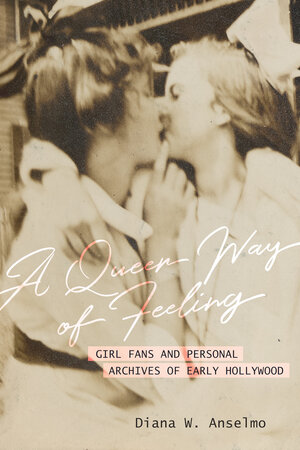Part of our Feminist Media Histories series, A Queer Way of Feeling gathers an unexplored archive of fan-made scrapbooks, letters, diaries, and photographs to explore how girls coming of age in the United States in the 1910s used cinema to forge a foundational language of female nonconformity, intimacy, and kinship. Pasting cross-dressed photos into personal scrapbooks and making love to movie actresses in epistolary writing, girl fans from all walks of life stitched together established homoerotic conventions with an emergent syntax of film stardom to make sense of feeling “queer” or “different from the norm.” These material testimonies show how a forgotten audience engendered terminologies, communities, and creative practices that became cornerstones of media fan reception and queer belonging.
Diana W. Anselmo is a feminist film historian and a queer immigrant. Her work has been featured in a number of journals, including Screen, Camera Obscura, Film History, the Journal of Cinema and Media Studies, and the Journal of Women’s History. Her research has received support from the Fulbright/Luso-American Development Foundation (FLAD), the National Endowment for the Humanities, Harvard University, and the International Association for Media and History, among others.
What motivated you to write A Queer Way of Feeling?
I grew up surrounded by “Girl Power” slogans. Though I grew up in a non-English-speaking country, Anglo-American media constantly sold me young female empowerment as a fait accompli. However, when I entered the professional world, I found that girlhood — and particularly “fangirls”— remained construed as nugatory, dismissible, a profitable commercial demographic that media industries addressed with little nuance or critical regard.
My decision to pursue a graduate education in the U.S. stemmed from this desire to probe the complex mix of fascination and repulsion American culture holds for girlhood, and how media uses it as a social construction to negotiate deep-seated anxieties regarding the maintenance of heteronormativity, patriarchal power, and whiteness.
A Queer Way of Feeling ultimately functions as one possible answer to the plural question: “how do we find lineages of marginalized people in the messiness of an exclusivist historical record such as that subtending Hollywood cinema?”
How do the findings of your book contribute to feminist media history?
I hope that by excavating the autobiographical materials of early movie-loving girls who felt different from the norm, my book offers a feminist method for tracking past audiences. The result is a history of cinema that is more diverse, more intimate, and one that feels more within our reach.
What was the process of writing and publishing the book like for you?
Like talking to dead people who get louder and louder until you pin them down through writing. It was an exciting, exhausting process that I will maybe do once again, though I promised myself once was enough!
Having a dedicated editorial team at UC Press really helped, though. I can’t recommend that enough: publish a book with a team that believes in your work and wants to see it come to fruition.
What was something unexpected or surprising that you learned while working on the book?
Dedicate yourself to a project that inspires curiosity, not love.
Love in scholarship can lead to attachments that are hard to kill, especially when it comes to editing or to accepting research dead-ends like a lack of primary sources, or changes in scholarly conversations that render your initial research questions moot, less urgent, or less nuanced.
Nuance is hard. Stick with it always. I am impatient by nature, so this book taught me to sit with objects and claims, and keep thinking through my blind spots. Curiosity helps locate blind spots, while love often obscures them.
As a first-gen scholar, what advice would you give other first-gen scholars hoping to publish a book?
Editing is your best friend. Kill your darlings. Now resurrect them in a different place. Don’t get too attached — you may have to kill them again.
Don’t rush a final manuscript or an incipient idea. Don’t be afraid to take time to let ideas mature or rot.
Take time off and rotate your mind crops. Fallow periods are as important as active writing and researching periods.
Follow your gut. People will tell you something has been done before or something is impossible. Commit yourself to being the impossible. It’s an irregular life-project but often the one that feels most rewarding.
Reach out to the people you admire, be it in conferences, classrooms, or emails. Networking is a corporate euphemism for “finding your people.” Find your people in the academic landscape—they will buoy you when the going gets hard.
Let go a lot. This may seem contradictory with “be the impossible,” but letting go allows you to recognize the opportunities that will move you forward joyfully—and those that won’t. This includes being open to criticism, especially during peer review. Some people may never get your work, but most experts have something valuable to add. Learning to parse through the brunt of criticism is a profoundly useful skill.
Being a first-gen scholar, to me, means being a queer, feminist, ESL immigrant who dedicated 15 years to carving a space at a table that has become more and more rarefied. It means a balance for sustainability built on an inherent feeling of difference. I think we don’t tell junior scholars enough that letting go is alright. Quitting an idea, a program, a project—is alright. “Quitting” is a capitalistic dirty word for “choosing differently.” Choosing differently is sometimes a privilege, but always a blessing you gift yourself. So be comfortable with choosing differently when it comes to your life work, including your book.
